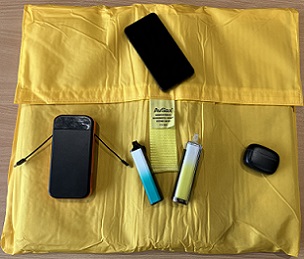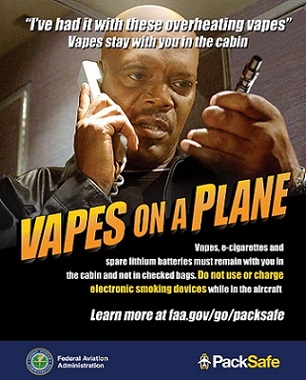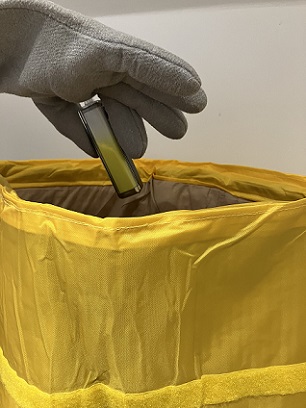 All these electronic devices - battery charger, vapes, earphones and mobile phone - are powered by lithium batteries and are seen on an AvSax fire mitigation bag.
All these electronic devices - battery charger, vapes, earphones and mobile phone - are powered by lithium batteries and are seen on an AvSax fire mitigation bag.
 The Vapes On A Plane safety campaign run by the Federal Aviation Administration
The Vapes On A Plane safety campaign run by the Federal Aviation Administration
 A vape being placed in an AvSax lithium fire mitigation bag
A vape being placed in an AvSax lithium fire mitigation bag
A lorry has been gutted in a blaze thought to be caused by vapes among recycling waste in Wales … but what happens if a vape catches fire on a plane?
The media has reported the fire on the Newtown bypass in Powys and fire crews found several vapes disposed of incorrectly among the 13 tonnes of mixed recycling in the vehicle’s trailer.
The vapes had been crushed, damaging the lithium batteries inside them and sparking the fire.
People will be shocked to discover that vapes are now the second biggest cause of lithium battery fires on board passenger planes.
All modern personal electronic devices are powered by lithium batteries – mobile phones, laptops, e-cigarettes/vapes and portable battery charges – and the main culprits for causing fires can be revealed.
According to the Federal Aviation Administration which regulates American airline operators and USA airspace, the worst device for causing fires by far are portable battery chargers – also known as battery packs – which have sparked 201 incidents since records began in 2006.
Second are vapes and e-cigarettes which together have caused 100 incidents even though people can’t even smoke on aircraft.
Mobile phones are third with 64 incidents and laptops fourth with 59.
In total there have been 483 verified lithium battery incidents recorded by the FAA from March 2006 to March 2024 but figures have rocketed in recent years and have been running at an average around one a week since 2017.
But that’s just in the USA which suggests hundreds more incidents will have happened elsewhere in the world but have gone unreported. No other regulatory authority releases lithium battery incident figures, including the Civil Aviation Authority in the UK.
The FAA was so worried about vape and e-cigarette fires it launched a Vapes On A Plane campaign last year, playing on the fears of the Snakes On A Plane film.
The most recent e-cigarette fire happened on an American Airlines flight from Charlotte in North Carolina to Las Vegas in Nevada on April 14, 2024. The pilot declared an emergency during the approach to Las Vegas after smoke was detected in the passenger cabin.
The source of the smoke was investigated by emergency crews and was found to be coming from the e-cigarette battery. They put the e-cigarette in a thermal containment bag and removed it from the aircraft.
When lithium batteries overheat they go into a chemical process called thermal runaway and when this happens it can produce enough heat – up to 900°C (1652°F) – to cause adjacent cells to overheat.
This can cause a lithium battery fire to flare repeatedly and they are then very difficult to put out. They can even explode.
Thousands of aircraft worldwide now carry AvSax lithium battery fire containment bags which won the Queen’s Award for Enterprise in the UK for their innovation and were devised by Environmental Defence Systems Ltd based in Huddersfield, Yorkshire. The Queen’s Award is the highest accolade any business can get.
AvSax managing director Richard Bailey said: “It will come as quite a shock to people to learn that battery chargers and vapes are responsible for so many fires on planes. The airline industry is responding with an increasing number of companies now acutely aware they need thermal containment bags on board, but too many still don’t.
“This means that when an incident happens, often at a cruising altitude of 35,000ft, the enclosed space of a passenger cabin can quickly fill with toxic smoke and the crew needs to divert and do an emergency landing. This is costly to the airline company and very disruptive for the passengers, not to mention the safety implications.
“Aircraft equipped with lithium battery containment bags such as AvSax usually carry on to their destination knowing the overheating device is safely contained.”
AvSax are now on board around 16,750 aircraft operated by more than 100 airline companies worldwide, including some of the best-known names in the aviation industry.
AvSax have been deployed in action at least 33 times on board aircraft since 2017 and on every occasion the aircraft was able to continue safely to its destination with no need to divert or make an emergency landing.
To make flying as safe as possible vapes, e-cigarettes and all personal electronic devices should be kept in the cabin, not in checked luggage, so if there is a problem with the battery the crew can deal with it. These devices should never be charged in the aircraft.
For more on AvSax go to www.avsax.com